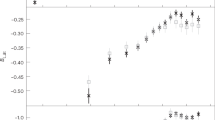Abstract
The exponential surface brightness profile (SBP) of a disk galaxy still has not been completely explained. In this study, we will explore this issue from the point of view of statistical mechanics. A simplified model is adopted here, which generalizes our previous work focusing on 3-dimensional spherical systems to study the disk’s radial and vertical distribution and reproduces the sech 2/N law of the vertical structure. For the radial structure we assume that the velocity dispersion is isotropic in the radial and tangential directions. In our method, the energy constraint vanishes, and the solution is only valid for some SBPs with truncation and large scale lengths relative to radius. When constraining the total angular momentum, the energy of the stellar disk and most of the radial SBPs of typical disks can be well described. Thus, the radial distribution of the stellar disk may be determined by both the random and orbital motions of stars. However, our model does not explain well those radial SBPs with an inner dip or those with a three-exponential law profile, for which we should further consider the validity of all our assumptions. In our fittings, the central gravitational force is set to be nonzero to include the effect of nonzero gravity at the center of the stellar disk.
Similar content being viewed by others
References
F.S. Patterson, Harvard Coll. Obs. Bull. 914, 9 (1940).
G. de Vaucouleurs, Astrophys. J. 128, 465 (1958).
L. Mestel, Mon. Not. R. Astron. Soc. 126, 553 (1963).
K.C. Freeman, Astrophys. J. 160, 811 (1970).
S.M. Fall, G. Efstathiou, Mon. Not. R. Astron. Soc. 193, 189 (1980).
H.J. Mo, F. van den Bosch, S.D.M. White, Galaxy Formation and Evolution (Cambridge University Press, New York, 2010).
D.N.C. Lin, J.E. Pringle, Astrophys. J. 320, L87 (1987).
P.C. van der Kruit, Astron. Astrophys. Suppl. Ser. 38, 15 (1979).
P. Erwin, J.E. Beckman, M. Pohlen, Astrophys. J. 626, L81 (2005).
J. Bakos, I. Trujillo, Astrophys. J. 683, 103 (2008).
M. Pohlen, I. Trujillo, Astron. Astrophys. 454, 759 (2006).
R.B. Larson, Mon. Not. R. Astron. Soc. 176, 31 (1976).
P.C. van der Kruit, K.C. Freeman, Annu. Rev. Astron. Astrophys. 49, 301 (2011).
D. Montgomery, Y.C. Lee, Mon. Not. R. Astron. Soc. 368, 380 (1991).
J.J. Aly, J. Perez, Phys. Rev. E 60, 5185 (1999).
T.N. Teles, Y. Levin, R. Pakter, F.B. Rizzato, J. Stat. Mech. 5, 7 (2010) arXiv:1004.0247.
P.H. Chavanis, arXiv:cond-mat/0212223.
D. Lynden-Bell, Mon. Not. R. Astron. Soc. 136, 101 (1967).
S. Tremaine, M. Henon, D. Lynden-Bell, Mon. Not. R. Astron. Soc. 219, 285 (1986).
S.D.M. White, R. Narayan, Mon. Not. R. Astron. Soc. 229, 103 (1987).
P.H. Chavanis, Astron. Astrophys. 381, 340 (2002).
J. Binney, S. Tremaine, Galactic Dynamics, 2nd edition (Princeton University Press, Princeton, New Jersey, 2008).
J. Hjorth, L.L.R. Williams, Astrophys. J. 722, 851 (2010).
A. Pontzen, F. Governato, Mon. Not. R. Astron. Soc. 430, 121 (2013).
D.B. Kang, P. He, Astron. Astrophys. 526, A147 (2011).
P. He, D.B. Kang, Mon. Not. R. Astron. Soc. 406, 2678 (2010).
D.B. Kang, EPL 98, 30011 (2012).
S.S. McGaugh, Galaxies 2, 601 (2014).
R. Dave, K. Finlator, B.D. Oppenheimer, Mon. Not. R. Astron. Soc. 421, 98 (2012).
D.N.C. Lin, J.E. Pringle, Astrophys. J. 320, L87 (1987).
P. Goldreich, D. Lynden-Bell, Mon. Not. R. Astron. Soc. 130, 125 (1965).
B. Barbanis, L. Woltjer, Astrophys. J. 150, 461 (1967).
J.J. Aly, Phys. Rev. E 49, 3771 (1994).
D.B. Kang, Astrophys. Space Sci. 349, 717 (2014).
T.S. van Albada, Mon. Not. R. Astron. Soc. 201, 939 (1982).
J. Hjorth, J. Madsen, Mon. Not. R. Astron. Soc. 265, 237 (1993).
L.J. Spitzer, Astrophys. J. 95, 329 (1942).
D. Burstein, Astrophys. J. 234, 829 (1979).
J.F. Navarro, C.S. Frenk, S.D.M. White, Astrophys. J. 490, 493 (1997).
L.P. Osipkov, Astrophysics 42, 451 (1999).
P. Erwin, M. Pohlen, J.E. Beckman, Astron. J. 135, 20 (2008).
L. Gutirrez, P. Erwin, R. Aladro, J.E. Beckman, Astron. J. 142, 145 (2014).
Author information
Authors and Affiliations
Corresponding author
Rights and permissions
About this article
Cite this article
Kang, DB., Cui, L. Possible explanation for the surface brightness profile of the stellar disk. Eur. Phys. J. Plus 130, 189 (2015). https://doi.org/10.1140/epjp/i2015-15189-x
Received:
Revised:
Accepted:
Published:
DOI: https://doi.org/10.1140/epjp/i2015-15189-x




